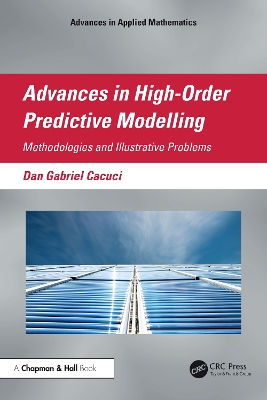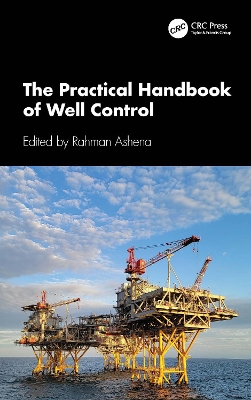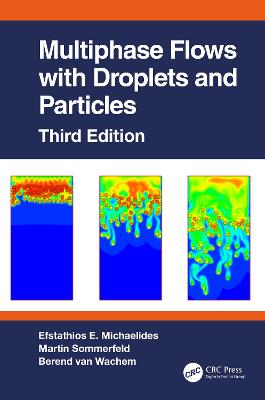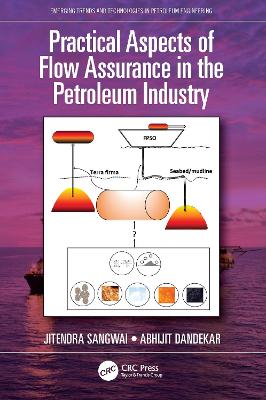Advances in High-Order Predictive Modeling
 portes grátis
portes grátis
Advances in High-Order Predictive Modeling
Methodologies and Illustrative Problems
Cacuci, Dan Gabriel
Taylor & Francis Ltd
12/2024
288
Dura
9781032740560
Pré-lançamento - envio 15 a 20 dias após a sua edição
Descrição não disponível.
CHAPTER 1: 2nd-BERRU-PM: Second-Order Maximum Entropy Predictive Modeling Methodology for Reducing Uncertainties in Predicted Model Responses and Parameters
1.1. Introduction
1.2. Generic Mathematical Modeling of a Physical System
1.3. Construction of the Minimally Discrepant Maximum Entropy Distribution
1.4. Construction of the Second-Order Minimally Discrepant Maximum Entropy Distribution of Experimentally Measured Responses and Parameters
1.5. 2nd-BERRU-PMD: Second Order MaxEnt Predictive Modeling Methodology with Deterministically Included Computed Responses
1.6. 2nd-BERRU-PMP: Second-Order MaxEnt Predictive Modeling Methodology with Probabilistically Included Computed Responses
1.6.1. Second-Order MaxEnt Probabilistic Representation of the Computational Model
1.6.2. General Case 2nd-BERRU-PMP: Inclusion of Additional External Measurements for Both Responses and Parameters
1.6.3. Practical Case 2nd-BERRU-PMP: Inclusion of Response Measurements
1.7. Inter-Comparison: 2nd-BERRU-PMP vs. 2nd-BERRU-PMD
1.7.1. Inter-Comparison: Best-Estimate Predicted Mean Values for Responses
1.7.2. Inter-Comparison: Best-Estimate Predicted Mean Values for Parameters
1.7.3. Inter-Comparison: Best-Estimate Predicted Response Covariances
1.7.4. Inter-Comparison: Best-Estimate Predicted Parameter Covariances
1.7.5. Inter-Comparison: Best-Estimate Predicted Correlations Between Parameters and Responses
1.8. Review of Principles Underlying the Data Adjustment and Data Assimilation Procedures
1.8.1. Principles Underlying the Data Adjustment Procedure
1.8.2. Principles Underlying the Data Assimilation Procedure
1.9. Discussion and Conclusions
CHAPTER 2: Application of the 2nd-BERRU-PM Methodology to the PERP Reactor Physics Benchmark
2.1. Introduction
2.2. Mathematical Modeling of the OECD/NEA Polyethylene-Reflected Plutonium Metal Sphere (PERP) Reactor Physics Benchmark
2.3: Mean and Variance of the PERP Benchmark's Computed Leakage Response
2.3.1. "High precision" parameters; uniform relative standard deviations
2.3.2. "Typical precision" parameters; uniform relative standard deviations
2.3.3. "Low precision" parameters; uniform relative standard deviations
2.4: Illustrative Application of the 2nd-BERRU-PM Methodology to the PERP Benchmark: Mathematical Expressions for the Best Estimate Predicted Mean and Variance for the PERP Leakage Response
2.4.1. Best-Estimate Predicted Mean Value, , for the PERP Leakage Response
2.4.2. Best-Estimate Predicted Standard Deviation for PERP Leakage Response
2.5: Typical-Precision Consistent Measured Response (neutrons/sec; )
2.5.1. High-precision (3% relative standard deviations) parameters
2.5.2: Typical precision (5% relative standard deviations) parameters
2.5.3. Low precision (10% relative standard deviations) parameters
2.6: Low-Precision Consistent Measured Response (neutrons/sec; ); High Precision Parameters (relative SD=3%)
2.7: Typical-Precision Inconsistent Measured Response ( neutrons/sec;
)
2.7.1. High-precision (2% relative standard deviations) parameters
2.7.2. Typical-precision (5% relative standard deviations) parameters
2.7.3. Low-precision (10% relative standard deviations) parameters
2.8: High-Precision Apparently Inconsistent Measured Response ( neutrons/sec; ) and High Precision Parameters (SD=3%)
2.8.1. Including Only Contributions from the 1st -Order Sensitivities of the Leakage Response to the Total Cross Sections
2.8.2. Including Contributions from the 1st + 2nd -Order Sensitivities of the Leakage Response to the Total Cross Sections
2.8.3. Including Contributions from the 1st + 2nd + 3rd-Order Sensitivities of the Leakage Response to the Total Cross Sections
2.8.4. Including Contributions from the 1st + 2nd + 3rd + 4th -Order Sensitivities of the Leakage Response to the Total Cross Sections
2.9: High-Precision Possibly Inconsistent Measured Response ( neutrons/sec; ) and Low Precision Parameters (SD=10%)
2.9.1. Including Only Contributions from the 1st -Order Sensitivities of the Leakage Response to the Total Cross Sections
2.9.2. Including Contributions from the 1st + 2nd -Order Sensitivities of the Leakage Response to the Total Cross Sections
2.10: Low-Precision Apparently Inconsistent Measured Response ( neutrons/sec; ); Typical Precision Parameters (SD=5%)
2.10.1. Including Only Contributions from the 1st -Order Sensitivities of the Leakage Response to All Important Parameters
2.10.2. Including Contributions from the 1st + 2nd -Order Sensitivities of the Leakage Response to All Important Parameters
2.10.3. Including Contributions from the 1st + 2nd + 3rd-Order Sensitivities of the Leakage Response to the Total Cross Sections
2.10.4. Including Contributions from the 1st + 2nd + 3rd + 4th -Order Sensitivities of the Leakage Response to the Total Cross Sections
2.11: Measured Response Value Coincides with Nominally Computed Response Value
2.12. Concluding Remarks
CHAPTER 3: A Novel Generic Fourth-Order Moment-Constrained Maximum Entropy Distribution
3.1. Introduction
3.2. Construction of the Fourth-Order Moment-Constrained Maximum Entropy (MaxEnt) Representation of Uncertain Multivariate Quantities
3.3. Concluding Remarks
Appendix 3.A. Auxiliary Computations for Constructing the Moment-Constrained Fourth-Order MaxEnt Distribution
Appendix 3.B. Approximations Inherent to the Fourth-Order Maximum Entropy Distribution
CHAPTER 4: 4th-BERRU-PM: Fourth-Order Maxent Predictive Modeling Methodology for Combining Measurements with Computations to Obtain Best-Estimate Results with Reduced Predicted Uncertainties
4.1. Introduction
4.2. Construction of the Moments-Constrained Fourth-Order MaxEnt Distribution of the Computational Model Parameters and Responses
4.3. Mathematical Framework of the 4th-BERRU-PM Methodology for Obtaining Best Estimate Results with reduced Uncertainties
4.3.1. Best-Estimate Fourth-Order Expression of the Vector of Mean Values of the Predicted Responses
4.3.2. Best-Estimate Fourth-Order Expression of the Vector of Mean Values of the Predicted Calibrated Model Parameters
4.3.3. Best-Estimate Fourth-Order Expression of the Covariance Matrix of the Predicted Responses
4.3.4. Best-Estimate Fourth-Order Expression of the Covariance Matrix of the Calibrated Model Parameters
4.3.5. Best-Estimate Fourth-Order Expression of the Correlation Matrix of the Predicted Responses and Calibrated Model Parameters
4.3.6. Best-Estimate Fourth-Order Expression of the Triple Correlations among Predicted Responses and Calibrated Model Parameters
4.3.7. Best-Estimate Fourth-Order Expression of the Quadruple Correlations among Predicted Responses and Calibrated Model Parameters
4.3.8. Indicator of Consistency among Parameters and Responses
4.4. Conclusions
Appendix 4.A. Auxiliary Computations for Constructing the Fourth-Order Maximum Entropy Distribution for Model Parameters and Responses
CHAPTER 5 :Application of the 4th-BERRU-PM Methodology to the PERP Reactor Physics Benchmark
5.1. Introduction
5.2. 4th-BERRU-PM Predicted Best-Estimate Posterior Mean and Variance for the PERP Leakage Response
5.2.1. Low Precision (Standard Deviation=10%) Measurement of the Leakage Response
5.2.1.a. "High precision" parameters (relative standard deviations )
5.2.1.b. "Typical precision" parameters (relative standard deviations )
5.2.1.c. "Low precision" parameters (standard deviations )
5.2.2. Typical Precision (Standard Deviation=5%) Measurement of the Leakage Response
5.2.2.a. "High" precision parameters (relative standard deviations )
5.2.2.b. "Typical" precision parameters (relative standard deviations )
5.3. 4th-BERRU-PM Best-Estimate Posterior Mean Values of Calibrated Model Parameters
5.3.1. "High" precision parameters (relative standard deviations )
5.3.2. "Typical" precision parameters (relative standard deviations )
5.4. 4th-BERRU-PM Best-Estimate Posterior Correlations Between Predicted Responses and Calibrated Model Parameters
5.4.1. "High" precision parameters (relative standard deviations )
5.4.2. "Typical precision" parameters (relative standard deviations )
5.5. 4th-BERRU-PM Best-Estimate Posterior Covariance Matrix of Calibrated Model Parameters
5.5.1. "High" precision parameters (relative standard deviations )
5.5.2. "Typical" precision parameters (relative standard deviations )
5.5.3. "Low" precision parameters (relative standard deviations ); "low" precision measurement ()
5.6. 4th-BERRU-PM Best-Estimate Posterior Skewness of Predicted Responses and Calibrated Model Parameters
5.7. 4th-BERRU-PM Best-Estimate Posterior Kurtosis of Predicted Responses and Calibrated Model Parameters
5.8. Concluding Remarks
CHAPTER 6: Fourth-Order Comprehensive Adjoint Sensitivity Analysis Methodology: Mathematical Framework
6.1. Introduction
6.2. First-Order Comprehensive Adjoint Sensitivity Analysis Methodology
6.3. Second-Order Comprehensive Adjoint Sensitivity Analysis Methodology
6.4. Third-Order Comprehensive Adjoint Sensitivity Analysis Methodology
6.5. Fourth-Order Comprehensive Adjoint Sensitivity Analysis Methodology
6.6. Concluding Remarks
CHAPTER 7: Polyethylene Reflected Plutonium (PERP) Reactor Physics Benchmark: Sensitivities of the Neutron Leakage Response to Total Cross Sections
7.1. Introduction
7.2. Computation of First-Order Sensitivities
7.3. Computation of Second-Order Sensitivities
7.4. Computation of Third-Order Sensitivities
7.5. Computation of Fourth-Order Sensitivities
7.6 Computational Considerations
7.7. Concluding Remarks
1.1. Introduction
1.2. Generic Mathematical Modeling of a Physical System
1.3. Construction of the Minimally Discrepant Maximum Entropy Distribution
1.4. Construction of the Second-Order Minimally Discrepant Maximum Entropy Distribution of Experimentally Measured Responses and Parameters
1.5. 2nd-BERRU-PMD: Second Order MaxEnt Predictive Modeling Methodology with Deterministically Included Computed Responses
1.6. 2nd-BERRU-PMP: Second-Order MaxEnt Predictive Modeling Methodology with Probabilistically Included Computed Responses
1.6.1. Second-Order MaxEnt Probabilistic Representation of the Computational Model
1.6.2. General Case 2nd-BERRU-PMP: Inclusion of Additional External Measurements for Both Responses and Parameters
1.6.3. Practical Case 2nd-BERRU-PMP: Inclusion of Response Measurements
1.7. Inter-Comparison: 2nd-BERRU-PMP vs. 2nd-BERRU-PMD
1.7.1. Inter-Comparison: Best-Estimate Predicted Mean Values for Responses
1.7.2. Inter-Comparison: Best-Estimate Predicted Mean Values for Parameters
1.7.3. Inter-Comparison: Best-Estimate Predicted Response Covariances
1.7.4. Inter-Comparison: Best-Estimate Predicted Parameter Covariances
1.7.5. Inter-Comparison: Best-Estimate Predicted Correlations Between Parameters and Responses
1.8. Review of Principles Underlying the Data Adjustment and Data Assimilation Procedures
1.8.1. Principles Underlying the Data Adjustment Procedure
1.8.2. Principles Underlying the Data Assimilation Procedure
1.9. Discussion and Conclusions
CHAPTER 2: Application of the 2nd-BERRU-PM Methodology to the PERP Reactor Physics Benchmark
2.1. Introduction
2.2. Mathematical Modeling of the OECD/NEA Polyethylene-Reflected Plutonium Metal Sphere (PERP) Reactor Physics Benchmark
2.3: Mean and Variance of the PERP Benchmark's Computed Leakage Response
2.3.1. "High precision" parameters; uniform relative standard deviations
2.3.2. "Typical precision" parameters; uniform relative standard deviations
2.3.3. "Low precision" parameters; uniform relative standard deviations
2.4: Illustrative Application of the 2nd-BERRU-PM Methodology to the PERP Benchmark: Mathematical Expressions for the Best Estimate Predicted Mean and Variance for the PERP Leakage Response
2.4.1. Best-Estimate Predicted Mean Value, , for the PERP Leakage Response
2.4.2. Best-Estimate Predicted Standard Deviation for PERP Leakage Response
2.5: Typical-Precision Consistent Measured Response (neutrons/sec; )
2.5.1. High-precision (3% relative standard deviations) parameters
2.5.2: Typical precision (5% relative standard deviations) parameters
2.5.3. Low precision (10% relative standard deviations) parameters
2.6: Low-Precision Consistent Measured Response (neutrons/sec; ); High Precision Parameters (relative SD=3%)
2.7: Typical-Precision Inconsistent Measured Response ( neutrons/sec;
)
2.7.1. High-precision (2% relative standard deviations) parameters
2.7.2. Typical-precision (5% relative standard deviations) parameters
2.7.3. Low-precision (10% relative standard deviations) parameters
2.8: High-Precision Apparently Inconsistent Measured Response ( neutrons/sec; ) and High Precision Parameters (SD=3%)
2.8.1. Including Only Contributions from the 1st -Order Sensitivities of the Leakage Response to the Total Cross Sections
2.8.2. Including Contributions from the 1st + 2nd -Order Sensitivities of the Leakage Response to the Total Cross Sections
2.8.3. Including Contributions from the 1st + 2nd + 3rd-Order Sensitivities of the Leakage Response to the Total Cross Sections
2.8.4. Including Contributions from the 1st + 2nd + 3rd + 4th -Order Sensitivities of the Leakage Response to the Total Cross Sections
2.9: High-Precision Possibly Inconsistent Measured Response ( neutrons/sec; ) and Low Precision Parameters (SD=10%)
2.9.1. Including Only Contributions from the 1st -Order Sensitivities of the Leakage Response to the Total Cross Sections
2.9.2. Including Contributions from the 1st + 2nd -Order Sensitivities of the Leakage Response to the Total Cross Sections
2.10: Low-Precision Apparently Inconsistent Measured Response ( neutrons/sec; ); Typical Precision Parameters (SD=5%)
2.10.1. Including Only Contributions from the 1st -Order Sensitivities of the Leakage Response to All Important Parameters
2.10.2. Including Contributions from the 1st + 2nd -Order Sensitivities of the Leakage Response to All Important Parameters
2.10.3. Including Contributions from the 1st + 2nd + 3rd-Order Sensitivities of the Leakage Response to the Total Cross Sections
2.10.4. Including Contributions from the 1st + 2nd + 3rd + 4th -Order Sensitivities of the Leakage Response to the Total Cross Sections
2.11: Measured Response Value Coincides with Nominally Computed Response Value
2.12. Concluding Remarks
CHAPTER 3: A Novel Generic Fourth-Order Moment-Constrained Maximum Entropy Distribution
3.1. Introduction
3.2. Construction of the Fourth-Order Moment-Constrained Maximum Entropy (MaxEnt) Representation of Uncertain Multivariate Quantities
3.3. Concluding Remarks
Appendix 3.A. Auxiliary Computations for Constructing the Moment-Constrained Fourth-Order MaxEnt Distribution
Appendix 3.B. Approximations Inherent to the Fourth-Order Maximum Entropy Distribution
CHAPTER 4: 4th-BERRU-PM: Fourth-Order Maxent Predictive Modeling Methodology for Combining Measurements with Computations to Obtain Best-Estimate Results with Reduced Predicted Uncertainties
4.1. Introduction
4.2. Construction of the Moments-Constrained Fourth-Order MaxEnt Distribution of the Computational Model Parameters and Responses
4.3. Mathematical Framework of the 4th-BERRU-PM Methodology for Obtaining Best Estimate Results with reduced Uncertainties
4.3.1. Best-Estimate Fourth-Order Expression of the Vector of Mean Values of the Predicted Responses
4.3.2. Best-Estimate Fourth-Order Expression of the Vector of Mean Values of the Predicted Calibrated Model Parameters
4.3.3. Best-Estimate Fourth-Order Expression of the Covariance Matrix of the Predicted Responses
4.3.4. Best-Estimate Fourth-Order Expression of the Covariance Matrix of the Calibrated Model Parameters
4.3.5. Best-Estimate Fourth-Order Expression of the Correlation Matrix of the Predicted Responses and Calibrated Model Parameters
4.3.6. Best-Estimate Fourth-Order Expression of the Triple Correlations among Predicted Responses and Calibrated Model Parameters
4.3.7. Best-Estimate Fourth-Order Expression of the Quadruple Correlations among Predicted Responses and Calibrated Model Parameters
4.3.8. Indicator of Consistency among Parameters and Responses
4.4. Conclusions
Appendix 4.A. Auxiliary Computations for Constructing the Fourth-Order Maximum Entropy Distribution for Model Parameters and Responses
CHAPTER 5 :Application of the 4th-BERRU-PM Methodology to the PERP Reactor Physics Benchmark
5.1. Introduction
5.2. 4th-BERRU-PM Predicted Best-Estimate Posterior Mean and Variance for the PERP Leakage Response
5.2.1. Low Precision (Standard Deviation=10%) Measurement of the Leakage Response
5.2.1.a. "High precision" parameters (relative standard deviations )
5.2.1.b. "Typical precision" parameters (relative standard deviations )
5.2.1.c. "Low precision" parameters (standard deviations )
5.2.2. Typical Precision (Standard Deviation=5%) Measurement of the Leakage Response
5.2.2.a. "High" precision parameters (relative standard deviations )
5.2.2.b. "Typical" precision parameters (relative standard deviations )
5.3. 4th-BERRU-PM Best-Estimate Posterior Mean Values of Calibrated Model Parameters
5.3.1. "High" precision parameters (relative standard deviations )
5.3.2. "Typical" precision parameters (relative standard deviations )
5.4. 4th-BERRU-PM Best-Estimate Posterior Correlations Between Predicted Responses and Calibrated Model Parameters
5.4.1. "High" precision parameters (relative standard deviations )
5.4.2. "Typical precision" parameters (relative standard deviations )
5.5. 4th-BERRU-PM Best-Estimate Posterior Covariance Matrix of Calibrated Model Parameters
5.5.1. "High" precision parameters (relative standard deviations )
5.5.2. "Typical" precision parameters (relative standard deviations )
5.5.3. "Low" precision parameters (relative standard deviations ); "low" precision measurement ()
5.6. 4th-BERRU-PM Best-Estimate Posterior Skewness of Predicted Responses and Calibrated Model Parameters
5.7. 4th-BERRU-PM Best-Estimate Posterior Kurtosis of Predicted Responses and Calibrated Model Parameters
5.8. Concluding Remarks
CHAPTER 6: Fourth-Order Comprehensive Adjoint Sensitivity Analysis Methodology: Mathematical Framework
6.1. Introduction
6.2. First-Order Comprehensive Adjoint Sensitivity Analysis Methodology
6.3. Second-Order Comprehensive Adjoint Sensitivity Analysis Methodology
6.4. Third-Order Comprehensive Adjoint Sensitivity Analysis Methodology
6.5. Fourth-Order Comprehensive Adjoint Sensitivity Analysis Methodology
6.6. Concluding Remarks
CHAPTER 7: Polyethylene Reflected Plutonium (PERP) Reactor Physics Benchmark: Sensitivities of the Neutron Leakage Response to Total Cross Sections
7.1. Introduction
7.2. Computation of First-Order Sensitivities
7.3. Computation of Second-Order Sensitivities
7.4. Computation of Third-Order Sensitivities
7.5. Computation of Fourth-Order Sensitivities
7.6 Computational Considerations
7.7. Concluding Remarks
Este título pertence ao(s) assunto(s) indicados(s). Para ver outros títulos clique no assunto desejado.
Non-linear systems;Particle Attenuation/Transmission
CHAPTER 1: 2nd-BERRU-PM: Second-Order Maximum Entropy Predictive Modeling Methodology for Reducing Uncertainties in Predicted Model Responses and Parameters
1.1. Introduction
1.2. Generic Mathematical Modeling of a Physical System
1.3. Construction of the Minimally Discrepant Maximum Entropy Distribution
1.4. Construction of the Second-Order Minimally Discrepant Maximum Entropy Distribution of Experimentally Measured Responses and Parameters
1.5. 2nd-BERRU-PMD: Second Order MaxEnt Predictive Modeling Methodology with Deterministically Included Computed Responses
1.6. 2nd-BERRU-PMP: Second-Order MaxEnt Predictive Modeling Methodology with Probabilistically Included Computed Responses
1.6.1. Second-Order MaxEnt Probabilistic Representation of the Computational Model
1.6.2. General Case 2nd-BERRU-PMP: Inclusion of Additional External Measurements for Both Responses and Parameters
1.6.3. Practical Case 2nd-BERRU-PMP: Inclusion of Response Measurements
1.7. Inter-Comparison: 2nd-BERRU-PMP vs. 2nd-BERRU-PMD
1.7.1. Inter-Comparison: Best-Estimate Predicted Mean Values for Responses
1.7.2. Inter-Comparison: Best-Estimate Predicted Mean Values for Parameters
1.7.3. Inter-Comparison: Best-Estimate Predicted Response Covariances
1.7.4. Inter-Comparison: Best-Estimate Predicted Parameter Covariances
1.7.5. Inter-Comparison: Best-Estimate Predicted Correlations Between Parameters and Responses
1.8. Review of Principles Underlying the Data Adjustment and Data Assimilation Procedures
1.8.1. Principles Underlying the Data Adjustment Procedure
1.8.2. Principles Underlying the Data Assimilation Procedure
1.9. Discussion and Conclusions
CHAPTER 2: Application of the 2nd-BERRU-PM Methodology to the PERP Reactor Physics Benchmark
2.1. Introduction
2.2. Mathematical Modeling of the OECD/NEA Polyethylene-Reflected Plutonium Metal Sphere (PERP) Reactor Physics Benchmark
2.3: Mean and Variance of the PERP Benchmark's Computed Leakage Response
2.3.1. "High precision" parameters; uniform relative standard deviations
2.3.2. "Typical precision" parameters; uniform relative standard deviations
2.3.3. "Low precision" parameters; uniform relative standard deviations
2.4: Illustrative Application of the 2nd-BERRU-PM Methodology to the PERP Benchmark: Mathematical Expressions for the Best Estimate Predicted Mean and Variance for the PERP Leakage Response
2.4.1. Best-Estimate Predicted Mean Value, , for the PERP Leakage Response
2.4.2. Best-Estimate Predicted Standard Deviation for PERP Leakage Response
2.5: Typical-Precision Consistent Measured Response (neutrons/sec; )
2.5.1. High-precision (3% relative standard deviations) parameters
2.5.2: Typical precision (5% relative standard deviations) parameters
2.5.3. Low precision (10% relative standard deviations) parameters
2.6: Low-Precision Consistent Measured Response (neutrons/sec; ); High Precision Parameters (relative SD=3%)
2.7: Typical-Precision Inconsistent Measured Response ( neutrons/sec;
)
2.7.1. High-precision (2% relative standard deviations) parameters
2.7.2. Typical-precision (5% relative standard deviations) parameters
2.7.3. Low-precision (10% relative standard deviations) parameters
2.8: High-Precision Apparently Inconsistent Measured Response ( neutrons/sec; ) and High Precision Parameters (SD=3%)
2.8.1. Including Only Contributions from the 1st -Order Sensitivities of the Leakage Response to the Total Cross Sections
2.8.2. Including Contributions from the 1st + 2nd -Order Sensitivities of the Leakage Response to the Total Cross Sections
2.8.3. Including Contributions from the 1st + 2nd + 3rd-Order Sensitivities of the Leakage Response to the Total Cross Sections
2.8.4. Including Contributions from the 1st + 2nd + 3rd + 4th -Order Sensitivities of the Leakage Response to the Total Cross Sections
2.9: High-Precision Possibly Inconsistent Measured Response ( neutrons/sec; ) and Low Precision Parameters (SD=10%)
2.9.1. Including Only Contributions from the 1st -Order Sensitivities of the Leakage Response to the Total Cross Sections
2.9.2. Including Contributions from the 1st + 2nd -Order Sensitivities of the Leakage Response to the Total Cross Sections
2.10: Low-Precision Apparently Inconsistent Measured Response ( neutrons/sec; ); Typical Precision Parameters (SD=5%)
2.10.1. Including Only Contributions from the 1st -Order Sensitivities of the Leakage Response to All Important Parameters
2.10.2. Including Contributions from the 1st + 2nd -Order Sensitivities of the Leakage Response to All Important Parameters
2.10.3. Including Contributions from the 1st + 2nd + 3rd-Order Sensitivities of the Leakage Response to the Total Cross Sections
2.10.4. Including Contributions from the 1st + 2nd + 3rd + 4th -Order Sensitivities of the Leakage Response to the Total Cross Sections
2.11: Measured Response Value Coincides with Nominally Computed Response Value
2.12. Concluding Remarks
CHAPTER 3: A Novel Generic Fourth-Order Moment-Constrained Maximum Entropy Distribution
3.1. Introduction
3.2. Construction of the Fourth-Order Moment-Constrained Maximum Entropy (MaxEnt) Representation of Uncertain Multivariate Quantities
3.3. Concluding Remarks
Appendix 3.A. Auxiliary Computations for Constructing the Moment-Constrained Fourth-Order MaxEnt Distribution
Appendix 3.B. Approximations Inherent to the Fourth-Order Maximum Entropy Distribution
CHAPTER 4: 4th-BERRU-PM: Fourth-Order Maxent Predictive Modeling Methodology for Combining Measurements with Computations to Obtain Best-Estimate Results with Reduced Predicted Uncertainties
4.1. Introduction
4.2. Construction of the Moments-Constrained Fourth-Order MaxEnt Distribution of the Computational Model Parameters and Responses
4.3. Mathematical Framework of the 4th-BERRU-PM Methodology for Obtaining Best Estimate Results with reduced Uncertainties
4.3.1. Best-Estimate Fourth-Order Expression of the Vector of Mean Values of the Predicted Responses
4.3.2. Best-Estimate Fourth-Order Expression of the Vector of Mean Values of the Predicted Calibrated Model Parameters
4.3.3. Best-Estimate Fourth-Order Expression of the Covariance Matrix of the Predicted Responses
4.3.4. Best-Estimate Fourth-Order Expression of the Covariance Matrix of the Calibrated Model Parameters
4.3.5. Best-Estimate Fourth-Order Expression of the Correlation Matrix of the Predicted Responses and Calibrated Model Parameters
4.3.6. Best-Estimate Fourth-Order Expression of the Triple Correlations among Predicted Responses and Calibrated Model Parameters
4.3.7. Best-Estimate Fourth-Order Expression of the Quadruple Correlations among Predicted Responses and Calibrated Model Parameters
4.3.8. Indicator of Consistency among Parameters and Responses
4.4. Conclusions
Appendix 4.A. Auxiliary Computations for Constructing the Fourth-Order Maximum Entropy Distribution for Model Parameters and Responses
CHAPTER 5 :Application of the 4th-BERRU-PM Methodology to the PERP Reactor Physics Benchmark
5.1. Introduction
5.2. 4th-BERRU-PM Predicted Best-Estimate Posterior Mean and Variance for the PERP Leakage Response
5.2.1. Low Precision (Standard Deviation=10%) Measurement of the Leakage Response
5.2.1.a. "High precision" parameters (relative standard deviations )
5.2.1.b. "Typical precision" parameters (relative standard deviations )
5.2.1.c. "Low precision" parameters (standard deviations )
5.2.2. Typical Precision (Standard Deviation=5%) Measurement of the Leakage Response
5.2.2.a. "High" precision parameters (relative standard deviations )
5.2.2.b. "Typical" precision parameters (relative standard deviations )
5.3. 4th-BERRU-PM Best-Estimate Posterior Mean Values of Calibrated Model Parameters
5.3.1. "High" precision parameters (relative standard deviations )
5.3.2. "Typical" precision parameters (relative standard deviations )
5.4. 4th-BERRU-PM Best-Estimate Posterior Correlations Between Predicted Responses and Calibrated Model Parameters
5.4.1. "High" precision parameters (relative standard deviations )
5.4.2. "Typical precision" parameters (relative standard deviations )
5.5. 4th-BERRU-PM Best-Estimate Posterior Covariance Matrix of Calibrated Model Parameters
5.5.1. "High" precision parameters (relative standard deviations )
5.5.2. "Typical" precision parameters (relative standard deviations )
5.5.3. "Low" precision parameters (relative standard deviations ); "low" precision measurement ()
5.6. 4th-BERRU-PM Best-Estimate Posterior Skewness of Predicted Responses and Calibrated Model Parameters
5.7. 4th-BERRU-PM Best-Estimate Posterior Kurtosis of Predicted Responses and Calibrated Model Parameters
5.8. Concluding Remarks
CHAPTER 6: Fourth-Order Comprehensive Adjoint Sensitivity Analysis Methodology: Mathematical Framework
6.1. Introduction
6.2. First-Order Comprehensive Adjoint Sensitivity Analysis Methodology
6.3. Second-Order Comprehensive Adjoint Sensitivity Analysis Methodology
6.4. Third-Order Comprehensive Adjoint Sensitivity Analysis Methodology
6.5. Fourth-Order Comprehensive Adjoint Sensitivity Analysis Methodology
6.6. Concluding Remarks
CHAPTER 7: Polyethylene Reflected Plutonium (PERP) Reactor Physics Benchmark: Sensitivities of the Neutron Leakage Response to Total Cross Sections
7.1. Introduction
7.2. Computation of First-Order Sensitivities
7.3. Computation of Second-Order Sensitivities
7.4. Computation of Third-Order Sensitivities
7.5. Computation of Fourth-Order Sensitivities
7.6 Computational Considerations
7.7. Concluding Remarks
1.1. Introduction
1.2. Generic Mathematical Modeling of a Physical System
1.3. Construction of the Minimally Discrepant Maximum Entropy Distribution
1.4. Construction of the Second-Order Minimally Discrepant Maximum Entropy Distribution of Experimentally Measured Responses and Parameters
1.5. 2nd-BERRU-PMD: Second Order MaxEnt Predictive Modeling Methodology with Deterministically Included Computed Responses
1.6. 2nd-BERRU-PMP: Second-Order MaxEnt Predictive Modeling Methodology with Probabilistically Included Computed Responses
1.6.1. Second-Order MaxEnt Probabilistic Representation of the Computational Model
1.6.2. General Case 2nd-BERRU-PMP: Inclusion of Additional External Measurements for Both Responses and Parameters
1.6.3. Practical Case 2nd-BERRU-PMP: Inclusion of Response Measurements
1.7. Inter-Comparison: 2nd-BERRU-PMP vs. 2nd-BERRU-PMD
1.7.1. Inter-Comparison: Best-Estimate Predicted Mean Values for Responses
1.7.2. Inter-Comparison: Best-Estimate Predicted Mean Values for Parameters
1.7.3. Inter-Comparison: Best-Estimate Predicted Response Covariances
1.7.4. Inter-Comparison: Best-Estimate Predicted Parameter Covariances
1.7.5. Inter-Comparison: Best-Estimate Predicted Correlations Between Parameters and Responses
1.8. Review of Principles Underlying the Data Adjustment and Data Assimilation Procedures
1.8.1. Principles Underlying the Data Adjustment Procedure
1.8.2. Principles Underlying the Data Assimilation Procedure
1.9. Discussion and Conclusions
CHAPTER 2: Application of the 2nd-BERRU-PM Methodology to the PERP Reactor Physics Benchmark
2.1. Introduction
2.2. Mathematical Modeling of the OECD/NEA Polyethylene-Reflected Plutonium Metal Sphere (PERP) Reactor Physics Benchmark
2.3: Mean and Variance of the PERP Benchmark's Computed Leakage Response
2.3.1. "High precision" parameters; uniform relative standard deviations
2.3.2. "Typical precision" parameters; uniform relative standard deviations
2.3.3. "Low precision" parameters; uniform relative standard deviations
2.4: Illustrative Application of the 2nd-BERRU-PM Methodology to the PERP Benchmark: Mathematical Expressions for the Best Estimate Predicted Mean and Variance for the PERP Leakage Response
2.4.1. Best-Estimate Predicted Mean Value, , for the PERP Leakage Response
2.4.2. Best-Estimate Predicted Standard Deviation for PERP Leakage Response
2.5: Typical-Precision Consistent Measured Response (neutrons/sec; )
2.5.1. High-precision (3% relative standard deviations) parameters
2.5.2: Typical precision (5% relative standard deviations) parameters
2.5.3. Low precision (10% relative standard deviations) parameters
2.6: Low-Precision Consistent Measured Response (neutrons/sec; ); High Precision Parameters (relative SD=3%)
2.7: Typical-Precision Inconsistent Measured Response ( neutrons/sec;
)
2.7.1. High-precision (2% relative standard deviations) parameters
2.7.2. Typical-precision (5% relative standard deviations) parameters
2.7.3. Low-precision (10% relative standard deviations) parameters
2.8: High-Precision Apparently Inconsistent Measured Response ( neutrons/sec; ) and High Precision Parameters (SD=3%)
2.8.1. Including Only Contributions from the 1st -Order Sensitivities of the Leakage Response to the Total Cross Sections
2.8.2. Including Contributions from the 1st + 2nd -Order Sensitivities of the Leakage Response to the Total Cross Sections
2.8.3. Including Contributions from the 1st + 2nd + 3rd-Order Sensitivities of the Leakage Response to the Total Cross Sections
2.8.4. Including Contributions from the 1st + 2nd + 3rd + 4th -Order Sensitivities of the Leakage Response to the Total Cross Sections
2.9: High-Precision Possibly Inconsistent Measured Response ( neutrons/sec; ) and Low Precision Parameters (SD=10%)
2.9.1. Including Only Contributions from the 1st -Order Sensitivities of the Leakage Response to the Total Cross Sections
2.9.2. Including Contributions from the 1st + 2nd -Order Sensitivities of the Leakage Response to the Total Cross Sections
2.10: Low-Precision Apparently Inconsistent Measured Response ( neutrons/sec; ); Typical Precision Parameters (SD=5%)
2.10.1. Including Only Contributions from the 1st -Order Sensitivities of the Leakage Response to All Important Parameters
2.10.2. Including Contributions from the 1st + 2nd -Order Sensitivities of the Leakage Response to All Important Parameters
2.10.3. Including Contributions from the 1st + 2nd + 3rd-Order Sensitivities of the Leakage Response to the Total Cross Sections
2.10.4. Including Contributions from the 1st + 2nd + 3rd + 4th -Order Sensitivities of the Leakage Response to the Total Cross Sections
2.11: Measured Response Value Coincides with Nominally Computed Response Value
2.12. Concluding Remarks
CHAPTER 3: A Novel Generic Fourth-Order Moment-Constrained Maximum Entropy Distribution
3.1. Introduction
3.2. Construction of the Fourth-Order Moment-Constrained Maximum Entropy (MaxEnt) Representation of Uncertain Multivariate Quantities
3.3. Concluding Remarks
Appendix 3.A. Auxiliary Computations for Constructing the Moment-Constrained Fourth-Order MaxEnt Distribution
Appendix 3.B. Approximations Inherent to the Fourth-Order Maximum Entropy Distribution
CHAPTER 4: 4th-BERRU-PM: Fourth-Order Maxent Predictive Modeling Methodology for Combining Measurements with Computations to Obtain Best-Estimate Results with Reduced Predicted Uncertainties
4.1. Introduction
4.2. Construction of the Moments-Constrained Fourth-Order MaxEnt Distribution of the Computational Model Parameters and Responses
4.3. Mathematical Framework of the 4th-BERRU-PM Methodology for Obtaining Best Estimate Results with reduced Uncertainties
4.3.1. Best-Estimate Fourth-Order Expression of the Vector of Mean Values of the Predicted Responses
4.3.2. Best-Estimate Fourth-Order Expression of the Vector of Mean Values of the Predicted Calibrated Model Parameters
4.3.3. Best-Estimate Fourth-Order Expression of the Covariance Matrix of the Predicted Responses
4.3.4. Best-Estimate Fourth-Order Expression of the Covariance Matrix of the Calibrated Model Parameters
4.3.5. Best-Estimate Fourth-Order Expression of the Correlation Matrix of the Predicted Responses and Calibrated Model Parameters
4.3.6. Best-Estimate Fourth-Order Expression of the Triple Correlations among Predicted Responses and Calibrated Model Parameters
4.3.7. Best-Estimate Fourth-Order Expression of the Quadruple Correlations among Predicted Responses and Calibrated Model Parameters
4.3.8. Indicator of Consistency among Parameters and Responses
4.4. Conclusions
Appendix 4.A. Auxiliary Computations for Constructing the Fourth-Order Maximum Entropy Distribution for Model Parameters and Responses
CHAPTER 5 :Application of the 4th-BERRU-PM Methodology to the PERP Reactor Physics Benchmark
5.1. Introduction
5.2. 4th-BERRU-PM Predicted Best-Estimate Posterior Mean and Variance for the PERP Leakage Response
5.2.1. Low Precision (Standard Deviation=10%) Measurement of the Leakage Response
5.2.1.a. "High precision" parameters (relative standard deviations )
5.2.1.b. "Typical precision" parameters (relative standard deviations )
5.2.1.c. "Low precision" parameters (standard deviations )
5.2.2. Typical Precision (Standard Deviation=5%) Measurement of the Leakage Response
5.2.2.a. "High" precision parameters (relative standard deviations )
5.2.2.b. "Typical" precision parameters (relative standard deviations )
5.3. 4th-BERRU-PM Best-Estimate Posterior Mean Values of Calibrated Model Parameters
5.3.1. "High" precision parameters (relative standard deviations )
5.3.2. "Typical" precision parameters (relative standard deviations )
5.4. 4th-BERRU-PM Best-Estimate Posterior Correlations Between Predicted Responses and Calibrated Model Parameters
5.4.1. "High" precision parameters (relative standard deviations )
5.4.2. "Typical precision" parameters (relative standard deviations )
5.5. 4th-BERRU-PM Best-Estimate Posterior Covariance Matrix of Calibrated Model Parameters
5.5.1. "High" precision parameters (relative standard deviations )
5.5.2. "Typical" precision parameters (relative standard deviations )
5.5.3. "Low" precision parameters (relative standard deviations ); "low" precision measurement ()
5.6. 4th-BERRU-PM Best-Estimate Posterior Skewness of Predicted Responses and Calibrated Model Parameters
5.7. 4th-BERRU-PM Best-Estimate Posterior Kurtosis of Predicted Responses and Calibrated Model Parameters
5.8. Concluding Remarks
CHAPTER 6: Fourth-Order Comprehensive Adjoint Sensitivity Analysis Methodology: Mathematical Framework
6.1. Introduction
6.2. First-Order Comprehensive Adjoint Sensitivity Analysis Methodology
6.3. Second-Order Comprehensive Adjoint Sensitivity Analysis Methodology
6.4. Third-Order Comprehensive Adjoint Sensitivity Analysis Methodology
6.5. Fourth-Order Comprehensive Adjoint Sensitivity Analysis Methodology
6.6. Concluding Remarks
CHAPTER 7: Polyethylene Reflected Plutonium (PERP) Reactor Physics Benchmark: Sensitivities of the Neutron Leakage Response to Total Cross Sections
7.1. Introduction
7.2. Computation of First-Order Sensitivities
7.3. Computation of Second-Order Sensitivities
7.4. Computation of Third-Order Sensitivities
7.5. Computation of Fourth-Order Sensitivities
7.6 Computational Considerations
7.7. Concluding Remarks
Este título pertence ao(s) assunto(s) indicados(s). Para ver outros títulos clique no assunto desejado.







